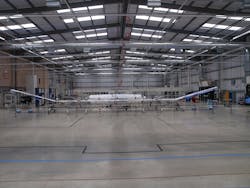The Farnborough International Airshow (FIA) is a global aviation and aerospace exhibition similar to the Paris Airshow. It has strong military and commercial aviation content, but this year it was also an impressive showcase of electric flight innovations from almost all fields.
Because the large number and importance of new electrification and E-flight ideas and projects we thought it only appropriate to talk about a few in our Electrification series.
Airbus Zephyr
For the first time ever Airbus allowed the media to visit the new Zephyr factory located on the Farnborough airfield in walking distance from the show. The Kelleher Building, which Airbus Defense and Space recently moved into, is a production site of the giant and brittle looking Zephyr S, HAPS (High Altitude Pseudo-Satellite) - actually an unmanned, solar-powered, 150-pound (70kg) light UAV that flies at 70,000 feet for weeks and eventually months at a time. Zephyr is officially described as having the wingspan of an A320 while weighing only as much as an airline seat. The Zephyr S is built from ultra-lightweight composites and features advanced ultra-efficient solar panels. The aircraft structure is built from carbon fiber composites and reinforced where needed by sandwich components and is covered by a transparent fabric. On each wing one unknown electric motor is located.
The original Zephyr 7, developed by QinetiQ in 2003, still holds the flight endurance record of two weeks, and during the show and the press conference, Airbus revealed that the first production unit, the Zephyr S, was undergoing its maiden flight in Arizona after being launched on July 11. The initial intention was that it will stay airborne for 30 days, doubling the existing world record before returning to the ground. Beyond this first flight, Airbus sees flights extending to 100 days, before the ultimate goal of staying aloft for a year at altitudes still to be defined but which may be between 70,000 and 80,000 feet.
More efficient batteries and solar panels mean Zephyr S is "even more capable than we were hoping for" according to Sophie Thomas, head of Zephyr Programme, opening up heavier and more sophisticated payloads, such as LIDAR or SAR radar. Initial results from the first flight were encouraging and the vehicle reportedly sustained daylight altitude 24 hours a day.
Rolls-Royce
Rolls-Royce created a show in the show with three different projects: EVTOL, ACCEL, and remotely even Aston Martin. Rolls–Royce appears to have jumped on the train giving it a strong push. Many, almost all other, projects have an Achilles heel when it comes to a proven range extender or combustion engine/generator unit. Rolls-Royce has the M250 gas turbine which can solve most energy problems of the power hungry VTOL applications.
The Rolls-Royce EVTOL project is part of a strategy to "champion electrification" and realize its ambition to become the world’s leading industrial technology company. It builds upon experience gained providing hybrid electric propulsion for non-aero applications, and its expertise in gas turbines, VTOL technology, systems analytics, and aerospace regulation and certification.
Rolls-Royce has become the latest major OEM to join a growing trend within the aviation industry around research and development programs focused on introducing e-VTOL air taxis, and other unique aircraft in the future. Rolls-Royce unveiled by surprise a concept, electric vertical take-off and landing (EVTOL) vehicle at the Farnborough International Airshow 2018. The aircraft should be capable of flying at 250 mph with a range of 500 miles. Presuming right partners and appropriate funding, Rolls-Royce believes it can start flight testing a full-scale prototype by 2020.
Rolls-Royce wants to be clear in its intentions and said to us that it unveiled a concept vehicle and is not looking to design the actual airframe and all of the other systems and components in house. The company uses its existing M250 gas-turbine to drive an electric generator which will serve as the energy source to power six electric motors and a battery that will provide some (limited) energy storage especially for the power demanding vertical flight.
“Our ambition is to become a supplier of the propulsion system for future EVTOL aircraft designs,” said Michael Cervenka, head of Future Business Propositions for Rolls-Royce. “We are looking for partners in terms of helping us with the electric propulsion system."
The initial concept vehicle uses gas turbine technology to generate electricity to power six - nondisclosed - electric propulsors specially designed to have a low noise profile. In this hybrid-EVTOL configuration it could carry four or five passengers at speeds up to 250 mph for approximately 500 miles, would not require re-charging (as the battery is charged by the gas turbine), and would be able to utilize existing infrastructure.
According to Cervenka, Rolls-Royce believes that an all-electric eVTOL aircraft would require a much longer time-line toward entry into service because of the infrastructure needed to support its battery charging, adding it is also developing a generator version to produce electricity. The future aircraft design would be fly-by-wire (FBW) and will also require a new type of full authority digital engine control (FADEC) system.
Rolls-Royce engineers are also developing software algorithms that will enable the FBW system to be controlled during the transition between hover and forward flight. Initially, the aircraft will be flown by a pilot, but it could eventually become pilot-less.
The intermediate design could be adapted for personal and public transport, logistics, and military applications and is based upon technologies that already exist or are currently under development. It could enter service in the early 2020s we've been told assuming collaboration with airframers and a range of strategic partners for aspects of the electrical system.
The EVTOL wings are able to rotate 90 degrees, enabling the vehicle to take off or land vertically. The propellers on the wing would fold away once the craft has reached cruising height, reducing drag and cabin noise, with the craft relying on two rear propellers for horizontal flight thrust.
Accelerating the Electrification of Flight-ACCEL
Rolls-Royce is leading a research project known as Accelerating the Electrification of Flight (ACCEL) to explore the use of a high power electrical system in a demonstrator aircraft. They are working with YASA, a UK manufacturer of high-power, light weight electric motors and controllers used in automotive, aerospace, and industrial applications.
A 12-foot carbon fiber airplane chassis which has been built combining Formula E auto racing and high-power battery development was exhibited in the Innovation Zone. Once complete, this plane will be the centerpiece of Rolls-Royce’s ACCEL initiative and it will be all electric. In a way it shows a new way of working at Rolls-Royce. The ACCEL team plans to build, test, and commercialize this product in a short timeframe.
The ACCEL initiative, short for accelerate, will use funding from the UK’s Aerospace Technology Institute and involves a host of UK partners including electric motor and controller manufacturer YASA and Electroflight Ltd. The Rolls-Royce digital team will be in the cockpit with them, running the data analytics and performance modeling. ACCEL plans to set new records for time to climb for an electrically powered aircraft, and highest voltage and highest power density achieved for an aircraft battery system.
Almost no technical data was disclosed and Cervenka was underlining that this airplane should not be understood as a model, and the purpose is to demonstrate the opportunities in electrification, and then to push a strategy that accelerates across the business.
Aston Martin Volante
The elite car maker drives toward aviation with its Volante project trying to create a new line in luxury urban mobility. Aston Martin is a newcomer in the world of aviation and in the VTOL world but appears serious about its intentions. What I could see in Farnborough gave to me as a pilot and aeronautical engineer much faith in this project as it was in my opinion one of the ripest newcomer projects I have seen in years. The adapted aerodynamic solutions, the chosen propulsion system and the overall design of a high-end, three-seat hybrid-electric VTOL is more than a bold try just to create a PR gag.
The Volante Vision, is a cooperation project started some 18 months ago with Aston Martin and its UK partners Cranfield University, Cranfield Aerospace Solutions, and Rolls-Royce. The Volante is a hybrid-electric aircraft that relies on a M250 gas-turbine/generator to drive its three propellers. It is projected to have a top speed of 175kt (320km/h), and a 216nm (400km) range – able to connect Paris and London.
Bell
Bell moved closer to unveiling the rotor system that will equip its future urban air mobility vehicle, with the manufacturer now settled on its preferred architecture. Closer doesn’t mean close enough to disclose it, but the program is moving from a conceptual to a preliminary design phase. Bell's 453kg (1,000-pound) maximum take-off weight air vehicle is being developed in collaboration with Uber for "Elevate" urban mobility initiative. Service entry is expected in the “early 2020s”.
Speaking at FAI, chief executive Mitch Snyder said Bell has recently selected Safran to supply a hybrid-electric power system for the aircraft; the biggest piece of the design.
Samad Aerospace
UK start-up Samad Aerospace created a great deal of interest in its eStarling and Starling Jet, with company chief executive Seyed Mohseni announcing on the eve of FIA that it has secured letters of intent for 103 examples of the electric and hybrid-electric-powered, VTOL business aircraft since the project was unveiled in February. The UK company had on display a 20 percent scale prototype of the aircraft. Samad is offering UAV Starling, six-seat e-Starling, and a 10-seat Starling Jet.
The e-Starling will have four electric-powered fans to deliver VTOL performance: two in its wing roots thrusting vertically and two on pylons farther aft, which are retracted when the fan is employed for forward movement. A gas turbine provides power for e-fans and battery charging.
Samad said the company will start building a 50 percent scale model in August and plans to fly it in 2020. Construction of the first of five full-scale prototypes will begin in early 2019; maiden flight is expected in 2021.
What's Next?
It is difficult to say how Electrification and E-Flight will evolve and affect our lives, our careers, and our future. It does appear like it is coming - and it is exciting. This Electrification and E-Flight series is nearing the end. We have attempted to expose our readers to a whole new emerging technology in our industry. In the final piece we hope to provide information on certification, maintenance and operation, and education of the people who will build and maintain this new breed of flying machines.



